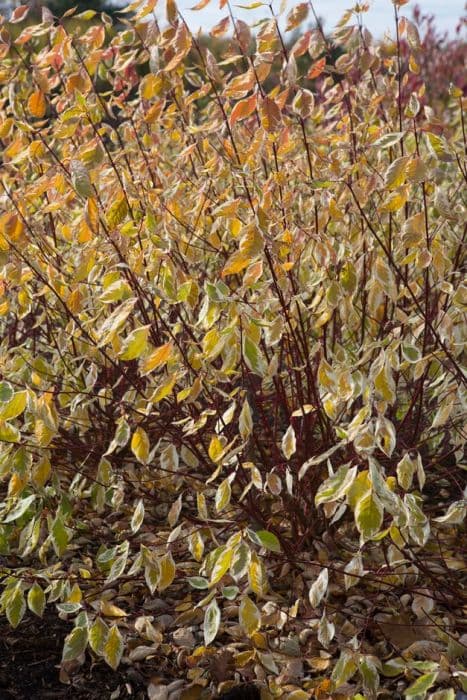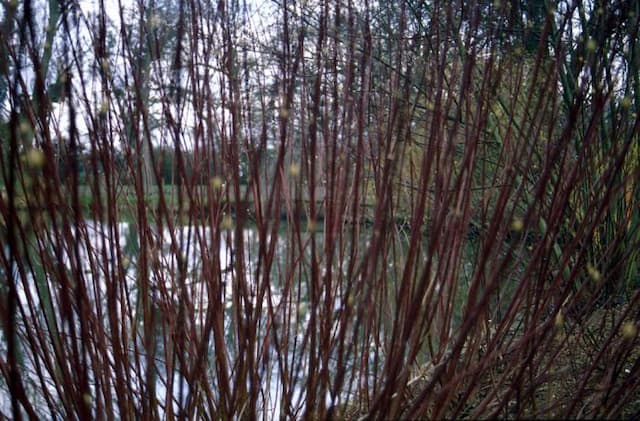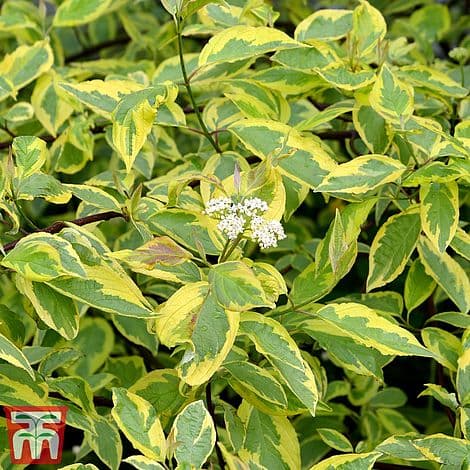Tatarian Dogwood Cornus alba 'Alleman's Compact'

ABOUT
Cornus alba 'Alleman's Compact', commonly known as the Tatarian dogwood, is a multi-stemmed, deciduous shrub with a dense and rounded form. Its branches are straight and slender, contributing to a well-structured appearance. During the spring and summer, the foliage consists of oval-shaped leaves that are colored a bright green, providing a fresh and lush appearance to the plant. As the seasons turn to fall, the leaves undergo a striking transformation, adopting a variety of hues including red, purple, and occasionally orange, which adds significantly to the plant's ornamental value. In contrast to its vibrant autumnal display, winter unveils another attractive feature: the stems. Once the leaves have fallen, the 'Alleman's Compact' variety reveals red-tinted stems that stand out against the often bleak winter landscape, providing visual interest during the colder months. Flowers on the Tatarian dogwood are petite and creamy-white, blooming in late spring to early summer. These blossoms are fairly inconspicuous when compared to the bright foliage and stems but add a delicate texture to the plant's profile. By late summer or early fall, the flowers give way to clusters of small, white to pale blue berries that are popular with birds, making it a friendly addition to wildlife gardens. All-year-round, the Tatarian dogwood 'Alleman's Compact' delivers a plethora of visual pleasures, with each season ushering in its own unique character, from vibrant greens to autumnal reds and the stark beauty of red stems against the winter snow. This versatile and hardy shrub is celebrated not only for its aesthetic qualities but also for its ability to provide habitat and food for local fauna.
About this plant
 Names
NamesFamily
Cornaceae.
Synonyms
Tatarian Dogwood, Siberian Dogwood, Red-barked Dogwood, Siberian Redtwig Dogwood, Red Twig Dogwood.
Common names
Cornus alba 'Alleman's Compact'.
 Toxicity
ToxicityTo humans
Red Twig Dogwood (Cornus alba) is generally considered to have a low level of toxicity to humans. Ingesting parts of the plant, particularly in large amounts, may cause mild stomach upset, but it is not typically known to cause severe poisoning or fatal reactions. However, it remains advisable to avoid consuming any part of the Red Twig Dogwood, as individual sensitivity to plants can vary. If ingestion occurs and any adverse symptoms are experienced, one should seek medical attention.
To pets
Red Twig Dogwood is also considered to have a low level of toxicity to pets. Similar to humans, if pets consume parts of the plant, they may experience mild gastrointestinal upset, such as vomiting or diarrhea. These symptoms are generally not severe, but it's still best to prevent pets from ingesting the plant. If a pet does consume Red Twig Dogwood and displays symptoms of distress, it is recommended to consult a veterinarian.
 Characteristics
CharacteristicsLife cycle
Perennials
Foliage type
Deciduous
Color of leaves
Green
Flower color
White
Height
3-4 feet (0.91-1.22 meters)
Spread
3-4 feet (0.91-1.22 meters)
Plant type
Shrub
Hardiness zones
2-8
Native area
Siberia
Benefits
 General Benefits
General Benefits- Attractive Foliage: Cornus alba 'Alleman's Compact' or Red Twig Dogwood has variegated leaves that provide visual interest throughout the growing season.
- Winter Interest: The plant boasts bright red stems that stand out against snowy landscapes, adding color to winter gardens.
- Erosion Control: With its dense foliage and root system, it helps prevent soil erosion in landscaped areas.
- Wildlife Habitat: It provides shelter and nesting sites for birds, while its berries serve as a food source.
- Low Maintenance: Red Twig Dogwood is easy to care for and requires minimal upkeep once established.
- Durable: It is hardy and able to withstand cold temperatures, making it suitable for a variety of climates.
- Versatility: The plant can be used in a wide range of landscape designs, including borders, mass plantings, and as a focal point.
- Tolerant of Various Soils: It can thrive in different soil types, although it prefers moist, well-drained ground.
 Medical Properties
Medical PropertiesThis plant is not used for medical purposes.
 Air-purifying Qualities
Air-purifying QualitiesThis plant is not specifically known for air purifying qualities.
 Other Uses
Other Uses- Cornus alba 'Alleman's Compact', commonly known as Tatarian dogwood, can be used for natural dye production, as the bark and leaves may produce varying shades depending on the mordant used.
- Its branches can be harvested in winter for decorative purposes in floral arrangements due to their striking red color that stands out against drab winter scenery.
- The shrub can be utilized in land reclamation projects since it can withstand challenging soil conditions and helps stabilize the soil with its dense root system.
- The plant can be used in noise reduction barriers as part of a dense planting scheme to absorb and diffuse sound pollution.
- Tatarian dogwood is sometimes incorporated into windbreaks or shelterbelts to protect more wind-sensitive plants and reduce soil erosion.
- Its dense foliage provides shelter and habitat for local wildlife, particularly birds that might nest within its branches.
- The plant can be used as a natural screen or privacy hedge due to its bushy growth habit, which creates a visual barrier between properties.
- Its vibrant fall foliage can be used as a natural indicator of seasonal change in educational settings, such as schools or nature centers.
- The species can be employed in the practice of coppicing, a traditional method of woodland management that involves repeatedly cutting back trees or shrubs to ground level to harvest shoots.
- Young, flexible stems of Tatarian dogwood may be used for basket-weaving or crafting due to their strength and pliability when soaked.
Interesting Facts
 Feng Shui
Feng ShuiThe Red Twig Dogwood is not used in Feng Shui practice.
 Zodiac Sign Compitability
Zodiac Sign CompitabilityThe Red Twig Dogwood is not used in astrology practice.
 Plant Symbolism
Plant Symbolism- Stability and Hope: The robust nature of the Tatarian Dogwood, which is steadfast throughout the seasons, symbolizes stability and hope in enduring the cyclical changes in life.
- Purity and Innocence: The pristine white blooms that appear in spring can symbolize purity and innocence, suggesting a fresh start or clean slate.
- Energy and Vitality: This plant's vigorous growth and ability to thrive in various conditions represent energy and vitality, an encouragement for resilience and dynamic living.
- Renaissance and New Beginnings: Like many plants that burst into bloom after a period of dormancy, the Tatarian Dogwood's cycle of renewal stands for renaissance and the emergence of new beginnings.
 Water
WaterThe Tatarian dogwood should be watered deeply once a week during its growing season, especially if rainfall is less than 1 inch per week. In the first growing season, ensure consistent moisture to establish a deep, extensive root system. As the plant matures, taper back the frequency but ensure the soil remains moist, not soggy. During drought conditions, water the equivalent of 1-2 gallons per week to maintain health. During winter, reduce watering but do not allow the soil to completely dry out.
 Light
LightThe Tatarian dogwood thrives best in full sun to partial shade. It should receive at least 4 hours of direct sunlight per day, but it can also benefit from some afternoon shade, especially in hotter climates. The ideal spot would be one where morning sunlight is abundant and direct, with dappled or partial shade in the afternoon.
 Temperature
TemperatureThe Tatarian dogwood is hardy and can tolerate a wide range of temperatures, growing best between 60°F and 75°F. It can withstand minimum winter temperatures down to -30°F. It's essential, however, to protect the plant from extreme heat; therefore, temperatures above 95°F might stress the plant.
 Pruning
PruningPrune the Tatarian dogwood in late winter to early spring to remove any dead, damaged, or diseased wood and to maintain plant shape. It's also beneficial to periodically prune out older stems to stimulate new growth, which will display the brightest red colors. The best time for this rejuvenation pruning is every two to three years.
 Cleaning
CleaningAs needed
 Soil
SoilThe Tatarian Dogwood 'Alleman's Compact' thrives best in a fertile, well-drained soil mix with a pH range between 5.5 and 7.5. A mix of loam, peat, and sand in equal parts can provide optimal growing conditions for this shrub. Ensuring good organic matter content and proper drainage is essential.
 Repotting
RepottingTatarian Dogwood 'Alleman's Compact' does not typically require frequent repotting as it is usually grown outdoors. However, if grown in containers, repotting every 2-3 years may be necessary to refresh the soil and accommodate root growth.
 Humidity & Misting
Humidity & MistingTatarian Dogwood 'Alleman's Compact' is adaptable to a range of humidity conditions outdoors. Ideal humidity levels for healthy growth are the average ambient humidity found in most temperate regions, without any specific requirements.
 Suitable locations
Suitable locationsIndoor
Place Tatarian Dogwood in bright, indirect light and cool temperatures.
Outdoor
Plant in part shade to full sun with mulch and space shrubs 2-3 feet apart.
Hardiness zone
2-7 USDA
 Life cycle
Life cycleCornus alba 'Alleman's Compact', commonly known as Tatarian Dogwood, begins its life as a dormant seed, which under proper conditions, germinates and develops into a seedling. The seedling grows rapidly into a juvenile plant, exhibiting green to variegated foliage, and in time, this juvenile plant matures into an adult shrub capable of flowering. During the adult stage, it undergoes seasonal cycles, producing clusters of small, white flowers in late spring to early summer which are then followed by the formation of white or blue-white berries. In autumn, the leaves of Tatarian Dogwood turn to shades of red and purple before falling off; this deciduous behavior prepares the plant for dormancy during the winter months. As spring arrives, the shrub breaks dormancy with new leaf growth, completing the annual growth cycle. Over many years, the mature plant might undergo rejuvenation through pruning or natural dieback, stimulating new growth and ensuring the continuation of its life cycle.
 Propogation
PropogationPropogation time
Early Spring
The most popular method for propagating the Red Twig Dogwood, scientifically known as Cornus alba 'Alleman's Compact', is through hardwood cuttings. This technique is typically carried out in the late fall or early winter when the plant is dormant. Gardeners should select healthy, mature stems from the current year's growth and cut them into segments about 6 to 9 inches (15 to 23 centimeters) long, making sure each cutting has at least two or three nodes. These cuttings are then planted directly in the ground or in pots with the bottom two-thirds of the cutting buried in a mix of sand and peat or a well-draining potting medium. To ensure a humid environment that encourages rooting, the pot can be covered with a plastic bag or placed inside a cold frame. The cuttings will gradually develop roots and can be transplanted to their permanent location in the following spring.









